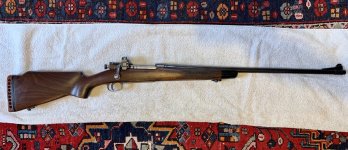Hello All,
I'm new to this Forum, and I've decided to try and find out what I can about the Springfield 1903 that's been sitting in my safe for 20 or so years. This CV-19 shutdown has given me more time to spend at home and shoot a bit. Another silver lining of the situation is trying to figure out this beautiful, old Springfield.
It's serial number is 547050 and it's in a Sporter stock. It has a 24" barrel, a Redfield rear peep site, inside of the stock has 4215 engraved, under the receiver there are 4 symbols: 6 M J 8 that are separate from one another.There is a P under the barrel. There is a 2 partially obscured under one side of the Lyman front site and what appears to be an 8 partially obscured under the other side.
There are a few more little markings, but I'm not sure which are important. I'll post pictures when I figure out how to do it. Any help with this is much appreciated.
Thanks, Ian
I'm new to this Forum, and I've decided to try and find out what I can about the Springfield 1903 that's been sitting in my safe for 20 or so years. This CV-19 shutdown has given me more time to spend at home and shoot a bit. Another silver lining of the situation is trying to figure out this beautiful, old Springfield.
It's serial number is 547050 and it's in a Sporter stock. It has a 24" barrel, a Redfield rear peep site, inside of the stock has 4215 engraved, under the receiver there are 4 symbols: 6 M J 8 that are separate from one another.There is a P under the barrel. There is a 2 partially obscured under one side of the Lyman front site and what appears to be an 8 partially obscured under the other side.
There are a few more little markings, but I'm not sure which are important. I'll post pictures when I figure out how to do it. Any help with this is much appreciated.
Thanks, Ian

